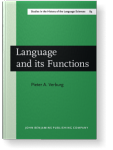Table of contents
Translator's Introductionxxi
Author's Prefacexxx
Chapter 1. Introduction1
Chapter 2. Classical Antiquity11
A synoptic view
Chapter 3. The Middle Ages31
Part I: The Realistic view of language: The Humanities at Orleans, Thomas Aquinas, Speculative Grammar, Raymond Lull
Chapter 4. The Middle Ages62
Part II: Non-realistic views of language: Abelard, Peter of Spain, William of Occam
Chapter 5. Humanism103
Part I: Introduction: Humanism in Italy: Bruni, Valla
Chapter 6. Humanism123
Part II: Humanism north of the Alps: Agricola, Erasmus, Vives; — Philology, Comparison of Languages, Erudition; — Ramus
Chapter 7. The Renaissance192
Critical attitudes towards Language — Bruno — Bacon
Chapter 8. Axiomatic Rationalism232
Introduction and Part I: Descartes, Hobbes, Locke, Leibniz
Chapter 9. Axiomatic Rationalism313
Part II: Artificial Languages: Wilkins; Wolff, Süssmilch, Lambert, Meiner
Chapter 10. Pragmatic Rationalism337
Introduction: Part I: Port-Royal, Shaftesbury, Harris, Monboddo — Condillac — De Brosses
Chapter 11. Pragmatic Rationalism399
Part II: — Further linguistic theories in the tradition of Port-Royal, Condillac and de Brosses
Chapter 12. The Aftermath of Rationalism413
Diderot and Rousseau — Hamann and Herder
Chapter 13. Linguistics and the Humanities436
The Study of the Classics in the Netherlands: A Preliminary View of Bopp — Conclusion
Appendix A: Revised opening of Chapter 5, in draft English translation463
Appendix B: Original Texts of Quotations470
Bibliography503
Chronological Table526
This article is available free of charge.
